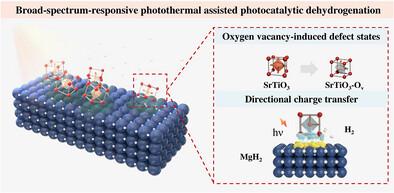Developing Oxygen Vacancy Rich Perovskite for Broad-Spectrum-Responsive Photothermal Assisted Photocatalytic Dehydrogenation of MgH2
IF 26
1区 材料科学
Q1 CHEMISTRY, PHYSICAL
引用次数: 0
Abstract
Magnesium hydride (MgH2) has been featured as a promising hydrogen storage medium however faces deployment barriers due to high thermodynamic stability and sluggish dehydrogenation kinetics. To address these limitations, a broad-spectrum-responsive SrTiO3-based perovskite (STO-450) particle, engineered with oxygen vacancies is introduced, as an effective photothermal-assisted photocatalyst for enhancing MgH2 dehydrogenation. It optimized MgH2-30 wt.% STO-450 composite desorbs 4.41 wt.% H2 at 184.7 °C under 1.152 W cm−2 (12 sun) irradiation, and 2.00 wt.% H2 at 152.2 °C under 0.576 W cm−2 (6 sun). In situ XPS, fs-TAS, and DFT reveal that oxygen vacancies act as electron traps, extending carrier lifetime and facilitating directional charge transfer across the MgH2/STO-450 heterointerface. This interfacial charge modulation substantially accelerates dehydrogenation kinetics. A levelized cost of hydrogen analysis shows over 50% energy cost reduction compared to conventional thermal routes. This work enables a practical strategy to significantly reduce the energy cost associated with long-distance H2 transport and high-pressure storage infrastructures.

广谱响应光热辅助光催化MgH2脱氢制备富氧空位钙钛矿
氢化镁(MgH2)是一种很有前途的储氢介质,但由于热力学稳定性高,脱氢动力学慢,存在部署障碍。为了解决这些限制,引入了一种广谱响应的srtio3基钙钛矿(STO-450)颗粒,通过氧空位工程设计,作为一种有效的光热辅助光催化剂,用于增强MgH2脱氢。优化后的MgH2-30 wt.% STO-450复合材料在1.152 W cm−2(12太阳)照射下,在184.7°C下解吸4.41 wt.% H2,在0.576 W cm−2(6太阳)照射下,在152.2°C下解吸2.00 wt.% H2。原位XPS、fs-TAS和DFT表明,氧空位充当了电子陷阱,延长了载流子寿命,促进了MgH2/STO-450异质界面上的定向电荷转移。这种界面电荷调制实质上加速了脱氢动力学。一项平均成本分析显示,与传统的热路径相比,氢的能源成本降低了50%以上。这项工作使一种实用的策略能够显著降低与长距离氢气运输和高压储存基础设施相关的能源成本。
本文章由计算机程序翻译,如有差异,请以英文原文为准。
求助全文
约1分钟内获得全文
求助全文
来源期刊

Advanced Energy Materials
CHEMISTRY, PHYSICAL-ENERGY & FUELS
CiteScore
41.90
自引率
4.00%
发文量
889
审稿时长
1.4 months
期刊介绍:
Established in 2011, Advanced Energy Materials is an international, interdisciplinary, English-language journal that focuses on materials used in energy harvesting, conversion, and storage. It is regarded as a top-quality journal alongside Advanced Materials, Advanced Functional Materials, and Small.
With a 2022 Impact Factor of 27.8, Advanced Energy Materials is considered a prime source for the best energy-related research. The journal covers a wide range of topics in energy-related research, including organic and inorganic photovoltaics, batteries and supercapacitors, fuel cells, hydrogen generation and storage, thermoelectrics, water splitting and photocatalysis, solar fuels and thermosolar power, magnetocalorics, and piezoelectronics.
The readership of Advanced Energy Materials includes materials scientists, chemists, physicists, and engineers in both academia and industry. The journal is indexed in various databases and collections, such as Advanced Technologies & Aerospace Database, FIZ Karlsruhe, INSPEC (IET), Science Citation Index Expanded, Technology Collection, and Web of Science, among others.
 求助内容:
求助内容: 应助结果提醒方式:
应助结果提醒方式:


